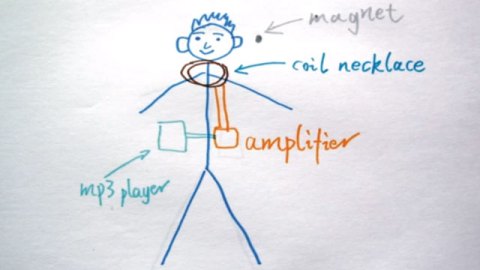Man implants magnet in his ear for use as wireless headphone

Don’t try this at home
A man who expects to soon be blind has implanted a magnet into his ear, which can now be used as a wireless headphone.
The man used a set of instructions for putting a small magnet in his ear, before a loop of copper wire is placed around the neck and attached to an amplifier and sound source. The system works in precisely the opposite way of a normal speaker: Instead of the magnet staying still and the copper wire pushing a diaphragm, the copper wire stays still around the user’s neck and the magnet vibrates, directly on the bones in the ear. Apparently the volume can even be controlled by “pressing on my tragus and moving the implant closer to the eardrum”.
The man has some pretty extreme ambitions, which aren’t actually as farfetched as they may sound:
“I plan to hook this thing up to an ultrasonic rangefinder so that hums can be heard when objects get closer or further away. This will basically give you a sense of echolocation like a bat has. This could be really handy for blind people (many of whom use echolocation for navigation) since it will be audible only to them and doesn’t require making clicking noises with your mouth or using some other manual noisemaker.”
He doesn’t want to stop there..
“Beyond that, I’d love to hook a geiger counter up to it and experience the world or radiation. Living near the old Nevada nuclear testing grounds provides a lot of opportunity for this. I wouldn’t mind finding some yellow cake uranium while on a hike because that stuff is expensive. Hearing a gentle hiss around warm objects might be a novel way to experience the thermal realm. The implant is going to allow for a lot of new senses. Plugging new sensors into the jack will allow me to experience a lot of the world that is normally invisible. Well, it still might be invisible but now it will be audible. This new synesthesia of sorts is an exciting way to explore the world and develop new instincts about the way the world works around you.”
It’s a fantastic experiment, I’m sure we’ll be seeing plenty of exciting developments in the future. It’s certainly going to rapidly become harder to tell if someone is wearing an ear piece.
To keep up to date with this blog you can follow Neurobonkers on Twitter, Facebook, RSS or join the mailing list.





